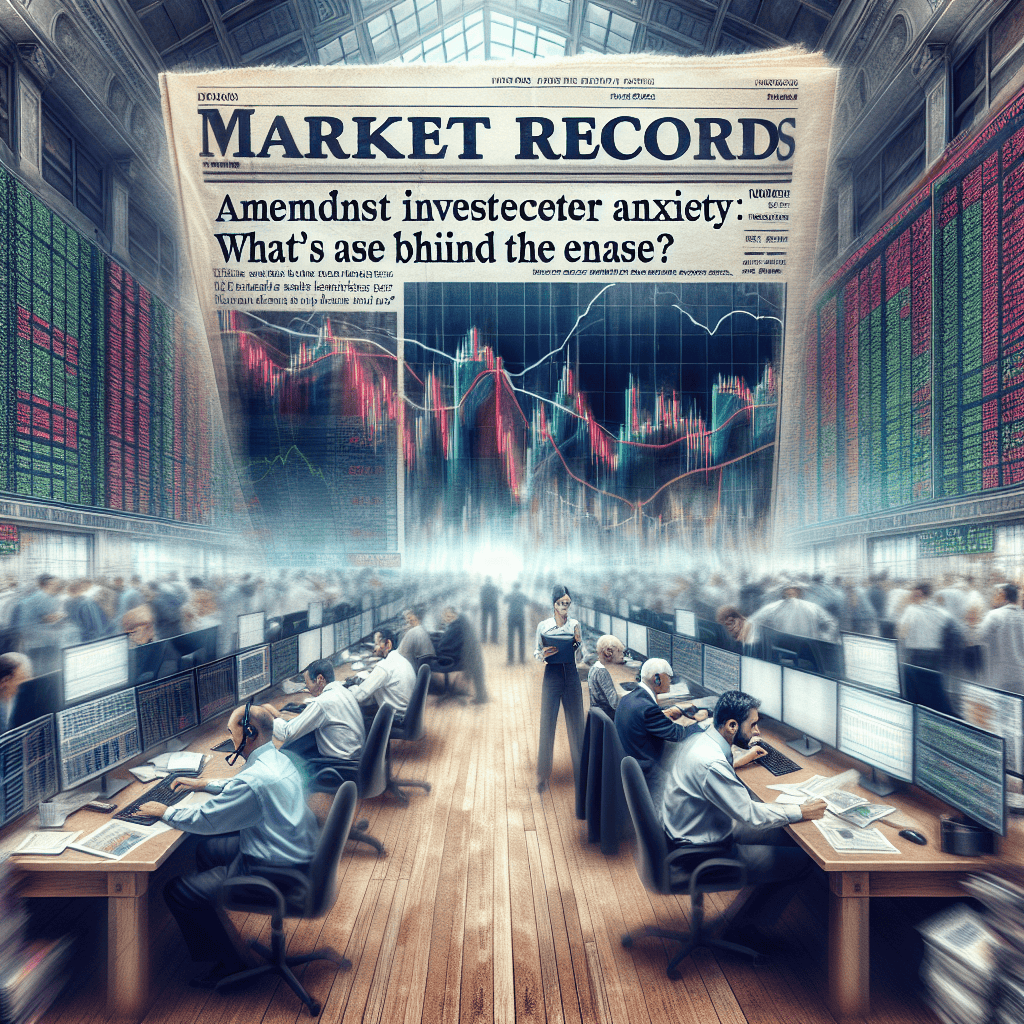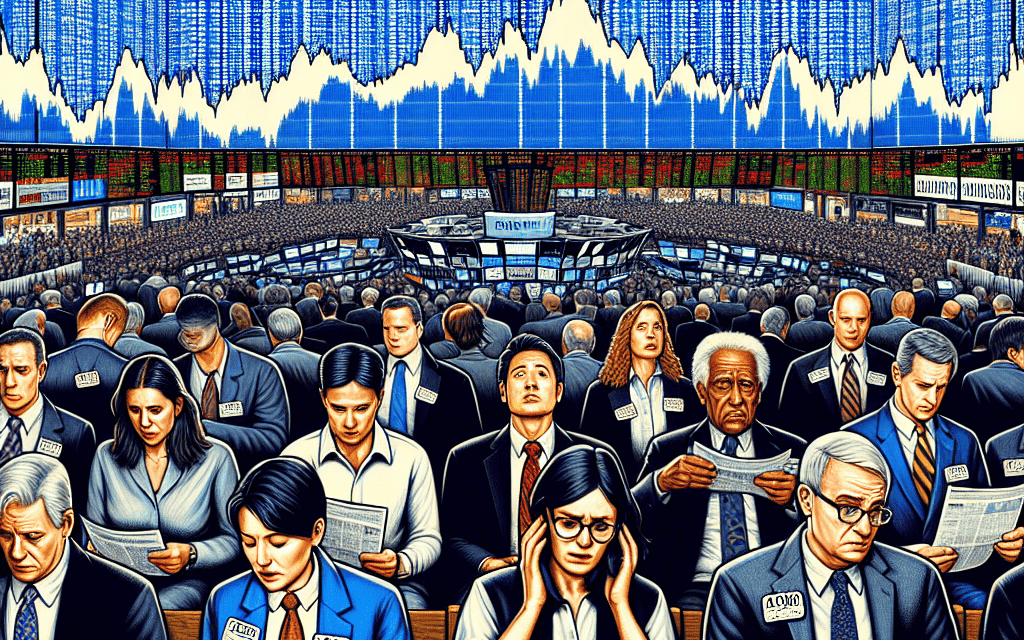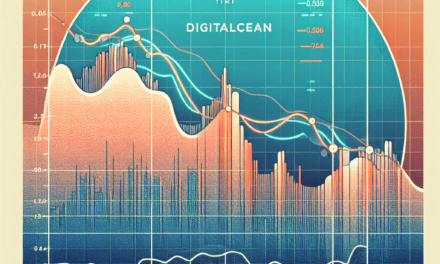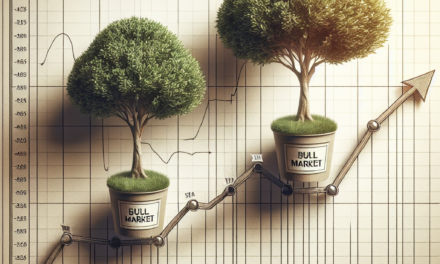“Navigating the Peaks: Unraveling Investor Jitters in a Record-Breaking Market”
Introduction
In recent months, global financial markets have experienced unprecedented highs, with major indices reaching record levels. However, this surge in market performance is juxtaposed with a palpable sense of unease among investors. Despite the apparent prosperity, underlying factors such as geopolitical tensions, inflationary pressures, and shifts in monetary policy have contributed to a climate of uncertainty. This dichotomy between market exuberance and investor anxiety raises critical questions about the sustainability of current trends and the potential risks that lie ahead. Understanding the root causes of this unease is essential for navigating the complexities of today’s financial landscape.
Understanding Investor Anxiety: Key Factors Driving Market Unease
Investor anxiety is a complex phenomenon that often arises from a confluence of factors, each contributing to the overall sentiment in the financial markets. As market records loom, understanding the underlying causes of this unease becomes crucial for both seasoned investors and newcomers alike. One of the primary drivers of investor anxiety is economic uncertainty. When economic indicators such as GDP growth, employment rates, and consumer spending show signs of volatility or decline, investors may become apprehensive about the future performance of their portfolios. This uncertainty can be exacerbated by geopolitical tensions, which often introduce additional layers of unpredictability into the global economic landscape.
Moreover, inflationary pressures have recently become a significant concern for investors. Rising inflation can erode purchasing power and lead to higher interest rates, which in turn can affect corporate profits and stock valuations. As central banks around the world grapple with the challenge of balancing inflation control with economic growth, their policy decisions are closely scrutinized by investors. The anticipation of interest rate hikes, for instance, can lead to market volatility as investors adjust their expectations and strategies accordingly.
In addition to economic factors, technological advancements and disruptions also play a role in shaping investor sentiment. The rapid pace of innovation in sectors such as artificial intelligence, renewable energy, and biotechnology presents both opportunities and challenges. While these advancements can drive growth and create new investment avenues, they also introduce uncertainties regarding regulatory changes, market adoption, and competitive dynamics. Investors must navigate these complexities to make informed decisions, which can contribute to a sense of unease.
Furthermore, corporate earnings reports and forecasts are critical in influencing investor confidence. Companies that fail to meet market expectations or provide cautious outlooks can trigger sell-offs and heightened anxiety. In contrast, strong earnings performance can bolster investor sentiment, although the pressure for continuous growth can also lead to concerns about sustainability and potential overvaluation.
Another factor contributing to investor anxiety is the increasing prevalence of environmental, social, and governance (ESG) considerations. As investors become more conscious of the impact of their investments on society and the environment, they face the challenge of integrating ESG criteria into their decision-making processes. This shift in focus can lead to uncertainty as investors assess the long-term implications of ESG factors on financial performance and market dynamics.
Moreover, the rise of retail investors and the influence of social media on market behavior have introduced new dynamics into the investment landscape. The democratization of trading platforms and the viral nature of information dissemination can lead to rapid market movements and increased volatility. While this democratization has empowered individual investors, it has also heightened the potential for market manipulation and speculative bubbles, contributing to overall anxiety.
In conclusion, investor anxiety is driven by a myriad of factors, ranging from economic uncertainty and inflationary pressures to technological disruptions and ESG considerations. As market records loom, understanding these underlying causes is essential for navigating the complexities of the financial markets. By staying informed and adopting a balanced approach, investors can better manage their anxiety and make strategic decisions that align with their long-term goals. As the investment landscape continues to evolve, maintaining a keen awareness of these factors will be crucial in mitigating unease and capitalizing on emerging opportunities.
Historical Market Records: Lessons from Past Economic Cycles
As investors navigate the complexities of today’s financial landscape, the specter of historical market records looms large, casting a shadow of anxiety over even the most seasoned market participants. Understanding the lessons from past economic cycles is crucial in deciphering the current unease that pervades the investment community. Historically, market records have often been precursors to periods of volatility, prompting investors to reflect on the patterns and outcomes of previous economic cycles.
To begin with, examining the historical context of market records reveals a pattern of exuberance followed by caution. For instance, the dot-com bubble of the late 1990s serves as a poignant reminder of how rapidly escalating stock prices, driven by speculative investments in technology companies, eventually led to a dramatic market correction. This cycle of boom and bust underscores the importance of maintaining a balanced perspective, even as markets reach unprecedented heights. Investors today are acutely aware of these historical precedents, which contributes to the prevailing sense of caution.
Moreover, the global financial crisis of 2008 further exemplifies the potential pitfalls of unchecked market enthusiasm. In the years leading up to the crisis, housing prices soared, fueled by easy credit and complex financial instruments. The subsequent collapse not only triggered a severe economic downturn but also highlighted the systemic risks inherent in financial markets. This historical episode serves as a stark reminder of the need for vigilance and prudent risk management, especially when markets appear to be setting new records.
In addition to these cautionary tales, it is essential to consider the broader economic factors that have historically influenced market cycles. Economic indicators such as interest rates, inflation, and employment levels play a pivotal role in shaping investor sentiment. For example, periods of low interest rates have historically spurred investment and economic growth, but they can also lead to asset bubbles if not managed carefully. Conversely, rising interest rates, often implemented to curb inflation, can dampen investor enthusiasm and lead to market corrections. Understanding these dynamics is crucial for investors seeking to navigate the current market environment.
Furthermore, technological advancements and globalization have introduced new variables into the equation, complicating the task of drawing direct parallels with past cycles. The rapid pace of innovation and the interconnectedness of global markets mean that economic cycles today may unfold differently than in the past. However, the fundamental principles of market behavior—driven by human psychology and economic fundamentals—remain largely unchanged. This continuity provides a valuable framework for interpreting current market conditions.
In light of these historical lessons, investors are increasingly focused on diversification and long-term strategies to mitigate risk. By spreading investments across various asset classes and geographic regions, they aim to reduce exposure to any single market downturn. Additionally, a long-term perspective allows investors to weather short-term volatility and capitalize on the growth potential of their investments over time.
In conclusion, while historical market records offer valuable insights into the cyclical nature of financial markets, they also serve as a reminder of the inherent risks and uncertainties that accompany periods of rapid growth. By learning from past economic cycles and remaining attuned to current economic indicators, investors can better navigate the challenges and opportunities that lie ahead. As market records continue to loom, the lessons of history provide a guiding light amidst the prevailing investor anxiety.
The Role of Global Events in Shaping Investor Sentiment
In recent months, the financial markets have been on a rollercoaster ride, with record highs and sudden dips creating a landscape of uncertainty for investors. This volatility is not merely a reflection of economic fundamentals but is also significantly influenced by global events that shape investor sentiment. Understanding the interplay between these events and market behavior is crucial for comprehending the current state of investor anxiety.
To begin with, geopolitical tensions have always played a pivotal role in influencing market dynamics. For instance, ongoing conflicts or diplomatic standoffs can lead to fluctuations in commodity prices, particularly oil and gas, which in turn affect global stock markets. Investors, wary of potential disruptions in supply chains and trade routes, often react by reallocating their portfolios, seeking safer assets such as gold or government bonds. This flight to safety can lead to a temporary dip in stock prices, even in the absence of direct economic indicators suggesting a downturn.
Moreover, economic policies and decisions made by major economies also contribute to shaping investor sentiment. Central banks, particularly the Federal Reserve in the United States, wield significant influence through their monetary policy decisions. Interest rate hikes or cuts, for instance, can lead to shifts in investor behavior as they reassess the cost of borrowing and the potential for economic growth. In recent times, the anticipation of policy changes has led to heightened market sensitivity, with investors closely monitoring statements from central bank officials for any hints of future actions.
In addition to geopolitical and economic factors, global health events have emerged as a critical determinant of market sentiment. The COVID-19 pandemic, for example, demonstrated how swiftly markets can react to health crises. The initial outbreak led to a sharp decline in global markets as investors grappled with the uncertainty surrounding the virus’s impact on economic activity. Subsequent waves and the emergence of new variants have continued to influence market behavior, underscoring the importance of health developments in shaping investor outlooks.
Furthermore, environmental concerns and climate-related events are increasingly becoming significant factors in investor decision-making. The growing awareness of climate change and its potential economic impacts has led to a shift towards sustainable investing. Investors are now more inclined to consider environmental, social, and governance (ESG) criteria when making investment decisions. This shift is not only a response to ethical considerations but also a recognition of the financial risks associated with climate change, such as regulatory changes and physical impacts on assets.
In light of these global events, it is evident that investor sentiment is shaped by a complex web of factors that extend beyond traditional economic indicators. The interconnectedness of global markets means that events in one part of the world can have far-reaching implications, influencing investor behavior across continents. As such, investors must remain vigilant, continuously assessing the potential impacts of global developments on their portfolios.
In conclusion, while market records may loom on the horizon, the underlying investor anxiety is a reflection of the multifaceted nature of global events. By understanding the role these events play in shaping sentiment, investors can better navigate the uncertainties of the financial markets. As the world continues to evolve, staying informed and adaptable will be key to managing the challenges and opportunities that lie ahead.
Analyzing Market Volatility: Strategies for Navigating Uncertain Times

In recent months, financial markets have been characterized by a notable increase in volatility, leaving investors grappling with uncertainty. This heightened market turbulence can be attributed to a confluence of factors, each contributing to the prevailing sense of unease. As market records loom, understanding the underlying causes of this volatility and exploring strategies to navigate these uncertain times becomes imperative for investors seeking to safeguard their portfolios.
One of the primary drivers of current market volatility is the ongoing geopolitical tensions that have cast a shadow over global economic stability. Trade disputes, political unrest, and diplomatic standoffs have created an environment of unpredictability, causing investors to reassess their risk exposure. For instance, the trade tensions between major economies have led to fluctuations in commodity prices and disrupted supply chains, thereby impacting corporate earnings and investor sentiment. Consequently, markets have experienced sharp swings as investors react to the latest developments in these geopolitical arenas.
In addition to geopolitical factors, macroeconomic indicators have also played a significant role in fueling market volatility. Inflationary pressures, interest rate hikes, and concerns over economic growth have all contributed to the current climate of uncertainty. Central banks around the world have been grappling with the challenge of balancing inflation control with economic growth, leading to divergent monetary policies. This divergence has, in turn, resulted in currency fluctuations and shifts in capital flows, further exacerbating market instability.
Moreover, the rapid pace of technological advancements and the rise of digital assets have introduced new dimensions of volatility. The proliferation of cryptocurrencies and the increasing integration of technology in financial markets have created both opportunities and challenges for investors. While digital assets offer the potential for high returns, they are also subject to extreme price swings and regulatory scrutiny. As a result, investors must navigate this evolving landscape with caution, balancing the allure of innovation with the risks inherent in these nascent markets.
Amidst this backdrop of volatility, investors are seeking strategies to mitigate risk and preserve capital. Diversification remains a cornerstone of prudent investment management, allowing investors to spread risk across different asset classes and geographic regions. By constructing a well-diversified portfolio, investors can reduce their exposure to any single market or economic event, thereby enhancing their resilience in the face of uncertainty.
Furthermore, adopting a long-term investment perspective can help investors weather short-term market fluctuations. By focusing on fundamental analysis and maintaining a disciplined approach, investors can avoid the pitfalls of emotional decision-making and capitalize on opportunities that arise during periods of market dislocation. Additionally, incorporating risk management tools such as stop-loss orders and options can provide an added layer of protection, enabling investors to limit potential losses while maintaining exposure to potential gains.
In conclusion, while market records may loom on the horizon, the path to achieving them is fraught with challenges. The interplay of geopolitical tensions, macroeconomic factors, and technological advancements has created a complex and volatile market environment. However, by understanding the underlying causes of this volatility and employing sound investment strategies, investors can navigate these uncertain times with confidence. As the financial landscape continues to evolve, staying informed and adaptable will be key to successfully managing risk and achieving long-term investment objectives.
The Impact of Interest Rates on Market Dynamics and Investor Confidence
As global financial markets continue to navigate a landscape marked by unprecedented challenges and opportunities, the impact of interest rates on market dynamics and investor confidence has become a focal point of discussion. In recent months, the specter of rising interest rates has loomed large over the investment community, creating a complex interplay between market records and investor anxiety. Understanding this relationship requires a nuanced exploration of how interest rates influence both the broader economy and individual investment decisions.
Interest rates, set by central banks, are a critical tool for managing economic growth and inflation. When rates are low, borrowing becomes cheaper, encouraging businesses to invest and consumers to spend, thereby stimulating economic activity. Conversely, higher interest rates can dampen economic growth by increasing the cost of borrowing, which can lead to reduced spending and investment. This delicate balance is at the heart of current market dynamics, as central banks around the world grapple with inflationary pressures and the need to sustain economic recovery in the wake of the COVID-19 pandemic.
In this context, the prospect of rising interest rates has injected a degree of uncertainty into financial markets. Investors, who have enjoyed a prolonged period of low rates and abundant liquidity, are now faced with the possibility of tighter monetary policy. This shift has the potential to alter the risk-reward calculus that underpins investment decisions. For instance, higher interest rates can lead to increased yields on bonds, making them more attractive relative to equities. This can result in a reallocation of capital, with investors moving away from riskier assets like stocks in favor of safer, income-generating securities.
Moreover, the anticipation of rising rates can also impact corporate earnings and valuations. Companies with significant debt loads may face higher interest expenses, which can erode profit margins and, in turn, affect stock prices. Additionally, higher rates can lead to a stronger currency, which can impact the competitiveness of export-driven businesses. These factors contribute to a more cautious investment environment, where market participants are keenly attuned to central bank communications and economic indicators that might signal future rate hikes.
Despite these challenges, it is important to recognize that rising interest rates are often a reflection of a strengthening economy. As such, they can be seen as a positive signal, indicating robust economic growth and improved labor market conditions. This duality underscores the complexity of the current market environment, where optimism about economic recovery coexists with concerns about inflation and monetary tightening.
In navigating this landscape, investor confidence plays a pivotal role. Confidence is shaped not only by economic fundamentals but also by perceptions of risk and uncertainty. As interest rates rise, maintaining confidence requires clear communication from policymakers and a transparent approach to monetary policy. Investors need assurance that rate hikes will be gradual and data-driven, minimizing the risk of abrupt market disruptions.
In conclusion, the interplay between interest rates, market dynamics, and investor confidence is a defining feature of the current financial landscape. While the prospect of rising rates has introduced a degree of anxiety, it also reflects underlying economic strength. As markets continue to set new records, understanding the nuances of this relationship will be crucial for investors seeking to navigate the challenges and opportunities that lie ahead. Through careful analysis and strategic decision-making, investors can position themselves to thrive in an environment characterized by both uncertainty and potential.
Behavioral Economics: How Psychology Influences Market Trends
In the intricate world of financial markets, the interplay between investor psychology and market trends is a subject of perennial interest. As market records loom on the horizon, a palpable sense of anxiety pervades among investors, raising questions about the underlying causes of this unease. Behavioral economics, a field that merges insights from psychology with economic theory, offers a compelling lens through which to examine these phenomena. By understanding the psychological factors at play, we can gain a deeper appreciation of how they influence market behavior and contribute to the current climate of apprehension.
At the heart of investor anxiety is the concept of loss aversion, a cornerstone of behavioral economics. This principle suggests that individuals experience the pain of losses more acutely than the pleasure of equivalent gains. As markets approach record highs, the fear of a potential downturn becomes more pronounced, overshadowing the excitement of potential gains. This fear is not unfounded; historical patterns have shown that market peaks are often followed by corrections or downturns, reinforcing the anxiety that investors feel as they navigate these uncertain waters.
Moreover, the role of cognitive biases cannot be understated in shaping investor behavior. Confirmation bias, for instance, leads individuals to seek out information that supports their existing beliefs while disregarding evidence to the contrary. In a market setting, this can result in investors becoming overly optimistic or pessimistic based on selective information, further fueling volatility. Similarly, the availability heuristic, which involves making judgments based on readily available information, can cause investors to overreact to recent news or events, amplifying market swings.
Social dynamics also play a crucial role in influencing market trends. Herd behavior, where individuals mimic the actions of a larger group, can lead to significant market movements. This phenomenon is particularly evident in times of uncertainty, as investors look to others for cues on how to act. The fear of missing out, or FOMO, can drive investors to make hasty decisions, buying into rising markets without fully considering the risks involved. Conversely, panic selling can occur when investors collectively decide to exit the market, exacerbating downward trends.
In addition to these psychological factors, the current economic environment adds another layer of complexity to investor sentiment. Global economic uncertainties, such as geopolitical tensions, inflationary pressures, and shifts in monetary policy, contribute to a climate of unpredictability. These external factors can heighten investor anxiety, as they introduce variables that are difficult to quantify and anticipate. The interplay between these macroeconomic elements and individual psychological responses creates a feedback loop that can significantly impact market dynamics.
Despite the challenges posed by these psychological and economic factors, it is important to recognize that they also present opportunities for astute investors. By understanding the behavioral tendencies that drive market trends, investors can develop strategies to mitigate risks and capitalize on potential gains. For instance, adopting a long-term perspective and maintaining a diversified portfolio can help cushion against short-term volatility. Additionally, staying informed and critically evaluating information can counteract the influence of cognitive biases.
In conclusion, as market records loom amidst investor anxiety, the insights provided by behavioral economics offer valuable guidance. By acknowledging the psychological underpinnings of market behavior, investors can better navigate the complexities of the financial landscape. While the path forward may be fraught with uncertainty, a nuanced understanding of these dynamics can empower investors to make informed decisions, ultimately contributing to a more resilient and adaptive market environment.
Future Outlook: Predicting Market Movements Amidst Current Uncertainties
As global markets continue to flirt with record highs, investor sentiment remains a complex tapestry woven with optimism and anxiety. The juxtaposition of these emotions is not without reason, as the current economic landscape presents a myriad of factors that both buoy and unsettle market participants. To understand the future outlook of market movements amidst these uncertainties, it is essential to delve into the underlying causes of this investor unease.
At the heart of the current market dynamics is the ongoing recovery from the global pandemic, which has left an indelible mark on economies worldwide. While many countries have made significant strides in returning to pre-pandemic levels of economic activity, the path to full recovery remains fraught with challenges. Supply chain disruptions, labor market imbalances, and inflationary pressures are just a few of the hurdles that continue to cast a shadow over the economic horizon. These factors contribute to a sense of unpredictability, making it difficult for investors to chart a clear course forward.
Moreover, central banks play a pivotal role in shaping market expectations, and their policies are closely scrutinized by investors seeking clues about future market movements. The delicate balancing act of managing interest rates and monetary policy to foster economic growth while keeping inflation in check is a task that central banks must navigate with precision. Any indication of a shift in policy, whether it be a rate hike or a tapering of asset purchases, can send ripples through the markets, amplifying investor anxiety.
In addition to these macroeconomic factors, geopolitical tensions add another layer of complexity to the investment landscape. Trade disputes, political instability, and international conflicts have the potential to disrupt markets and create volatility. Investors must remain vigilant, as these geopolitical developments can have far-reaching implications for global trade and economic stability.
Despite these challenges, there are reasons for cautious optimism. Technological advancements and innovation continue to drive growth in various sectors, offering new opportunities for investment. The transition to a more sustainable economy, for instance, has spurred interest in renewable energy and green technologies, which are poised to play a significant role in shaping future market trends. Furthermore, the resilience demonstrated by businesses and consumers in adapting to new realities underscores the potential for continued economic recovery.
As investors navigate this complex environment, diversification remains a key strategy for managing risk. By spreading investments across different asset classes and geographies, investors can mitigate the impact of market volatility and position themselves to capitalize on emerging opportunities. Additionally, maintaining a long-term perspective can help investors weather short-term fluctuations and focus on the underlying fundamentals that drive market performance.
In conclusion, while the prospect of market records looms large, the path forward is not without its uncertainties. The interplay of economic recovery, central bank policies, geopolitical tensions, and technological advancements will continue to shape market movements in the coming months. By staying informed and adopting a balanced approach to investment, investors can navigate these challenges and seize opportunities as they arise. As the global economy evolves, the ability to adapt and respond to changing conditions will be crucial in predicting and understanding future market trends.
Q&A
1. **What are market records?**
Market records refer to the highest levels reached by stock market indices, such as the S&P 500, Dow Jones Industrial Average, or NASDAQ, indicating strong performance and investor confidence.
2. **Why is there investor anxiety despite market records?**
Investor anxiety can stem from various factors, including geopolitical tensions, economic uncertainty, inflation concerns, or potential interest rate hikes, which may overshadow positive market performance.
3. **How do geopolitical tensions contribute to investor unease?**
Geopolitical tensions can lead to market volatility and uncertainty, as investors worry about potential impacts on global trade, supply chains, and economic stability.
4. **What role does inflation play in creating investor anxiety?**
Rising inflation can erode purchasing power and lead to higher interest rates, which may increase borrowing costs and reduce corporate profits, causing concern among investors.
5. **How do interest rate hikes affect market sentiment?**
Interest rate hikes can lead to higher borrowing costs for businesses and consumers, potentially slowing economic growth and reducing corporate earnings, which can negatively impact market sentiment.
6. **What impact does economic uncertainty have on investor behavior?**
Economic uncertainty can lead to cautious investor behavior, as concerns about future growth prospects and potential downturns may prompt investors to seek safer assets or reduce exposure to equities.
7. **How can investors manage anxiety amidst market records?**
Investors can manage anxiety by diversifying their portfolios, focusing on long-term investment strategies, staying informed about market trends, and consulting with financial advisors to make informed decisions.
Conclusion
The conclusion about the market records amidst investor anxiety is that while markets have reached unprecedented highs, underlying unease stems from a combination of factors including geopolitical tensions, inflationary pressures, and potential interest rate hikes. These elements contribute to uncertainty about future economic stability and corporate earnings, prompting investors to remain cautious despite the bullish market trends. The juxtaposition of record market performance with investor anxiety highlights the complex interplay between optimistic market momentum and the underlying economic and geopolitical challenges that could impact future growth.





